Dog Walkin’ Wellington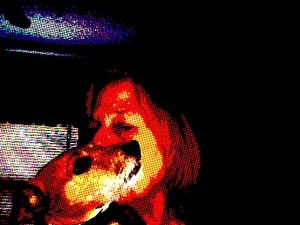
The Boxer
By Barbara Phillippi
I have some new neighbors up the street, and as I drive to town, I often see a family member exercising two handsome, fawn-coated Boxers. A Boxer rescue was the first breed we owned when we I was first married, but I never really knew much about the history of this striking dog, and we didn’t have him long enough to learn much about breed traits. I do remember that he was a sweet, energetic, goofy guy, who surely didn’t meet any breed standard. This past year the Boxer was the 7th most popular breed in the US.
The Boxer’s (also known as the Deutscher Boxer, German Boxer) history is replete with images and writings of similar dogs from all over the world, including cave paintings in Spain, and manuscript sketches in Greece. Boxers are included in the general category of Molosser canines, which include Mastiff types such as the Bullmastiff, Dogouoe de Bordeaus, Pyrenean Mastiff, Spanish Mastiff, Tibetan Mastiff, etc. The name Molosser derives from King Mollosus of Epirus, an area historically claimed by such modern countries as Greece and Albania, and some suspect the breed originated here. Many others breeds, like the Boxer, fall into the larger category of “Molossers”, but each is a separate and distinct breed, as it is a creation from other Molossers, including the Old English Bulldog.
So much for the confusion. German breeders get the credit for this breed’s fame, both in refining the standards, increasing its popularity, and promoting its status as a recognized breed. Boxer Clubs were formed in Germany as early as 1895. The breed began winning championships in 1915, and its popularity skyrocketed; it quickly became a show favorite.
AKC (American Kennel Club) registration of Boxers didn’t take place until 1904. At that time, white was the most common color. Now, white is not accepted as a breed standard at all. The only accepted colors are fawn, brindle, and mahogany. There can be white markings, but the dog may be disqualified if they make up more than a third of the coat. The coat is very short and shiny, and lies very close to the skin of the dog. The nose should be black, the muzzle square, with a slight under bite.
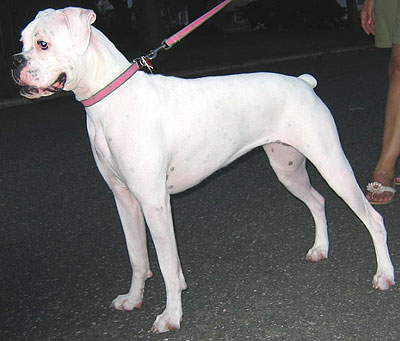
One cannot discuss this handsome dog without addressing an ever-raging debate over the practice of ear cropping, and there are early photos picturing the dogs with both preferences. The ears are set high, and when cropped, they are trained to stand up on the head, tapering to a point. When left natural the ears are thin, falling forward, lying close to the head. Cropping is done when a puppy reaches the correct age, usually four months. He goes to the vet, he’s put to sleep, and the vet removes a portion of the dog’s ears. Then the ears are taped up and joined together at the tips to help train them to grow erect.
This practice has been outlawed throughout most of Europe, but is still allowed, and even encouraged in the United States. Docked tails are also illegal in other nations, but the AKC severely penalizes a natural tail. A comment on a popular Boxer aficionado website:
“Although I like the cropped look because it provides a regal disposition to the breed, I personally prefer the natural ‘hang-ears’ more because they look so much goofier with their crazy floppy ears. Plus, there is no unneeded discomfort and sedation for the poor little furballs.” Also, the AKC severely penalizes a natural tail, while most of Europe has outlawed this practice also.
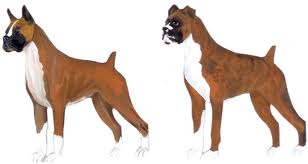
It is said that the breed name comes from a propensity of these dogs to stand on their hind legs and hit out with their front paws, like a human boxer. But most experts say: “With regards to the origin of the name ‘BOXER,’ all the books say the same, that no one knows exactly how the name came about!”
Based on 2011 American Kennel Club statistics, Boxers are the seventh most popular breed of dog in the United States for the second year in a row, moving down from sixth, where they were ranked for the previous three years. They are fiercely loyal companions, and not fond of strangers, making them excellent guard dogs.
I spoke with the Garibotti family, who live near Cleveland OH, and they sent me photos of their 1 1/2 year old dog Caesar, light brindle and white, who is the family’s second Boxer. Arlene, Mom of Sergio and Melissa, says, “They’re smart dogs. He’s high energy, loves everybody, is good with other animals.” A great companion, “Caesar always waits nearby while Sergio takes a shower.” In the photo, they all watch the first snowfall.
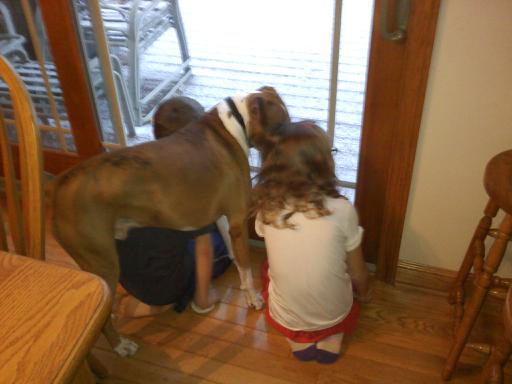
Boxers are popular Hollywood pets; owners include Humphrey Bogart and Lauren Bacall, Shirley MacLaine, George Clooney, Jodie Foster, and Justin Timberlake. The first official mascot for the Miami Hurricanes was a 65-pound brown and white boxer dog named Hurricane I! This dog was chosen in 1950, and wore an orange and green blanket with his name in white.
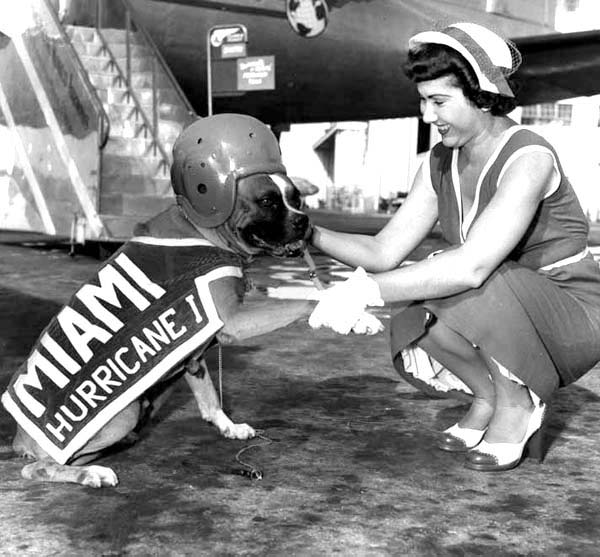
Interesting Fact: Boxers were used by the United States in World War I as messenger dogs.
A great UK website has links to history and photos of great foundation Boxer dogs, and I include it here for those who wish to explore the breed in greater depth:
http://www.ukboxerdogs.co.uk/history.html
(Note: There is some advertising on this page.)
Until next month, Happy New Year, and remember:
“In a perfect world, every home would have a dog, and every dog would have a dog.”
Over a lifetime, Barbara Phillippi has had mostly “normal” dogs – a few German Shepherds and a bunch of wonderful “mutts,” each with its own wonderful, quirky, qualities. For many years, she taught 4-H dog obedience courses, under the authorization of Cornell University’s Cooperative Extension Services. That terrific program teaches the basics of dog behavior, of every breed, to young dog owners. Today she lives in Wellington with three Jack Russell Terriers – Woody, Gracie, and Buck. “These guys showed me a learning curve that I never knew existed!”

